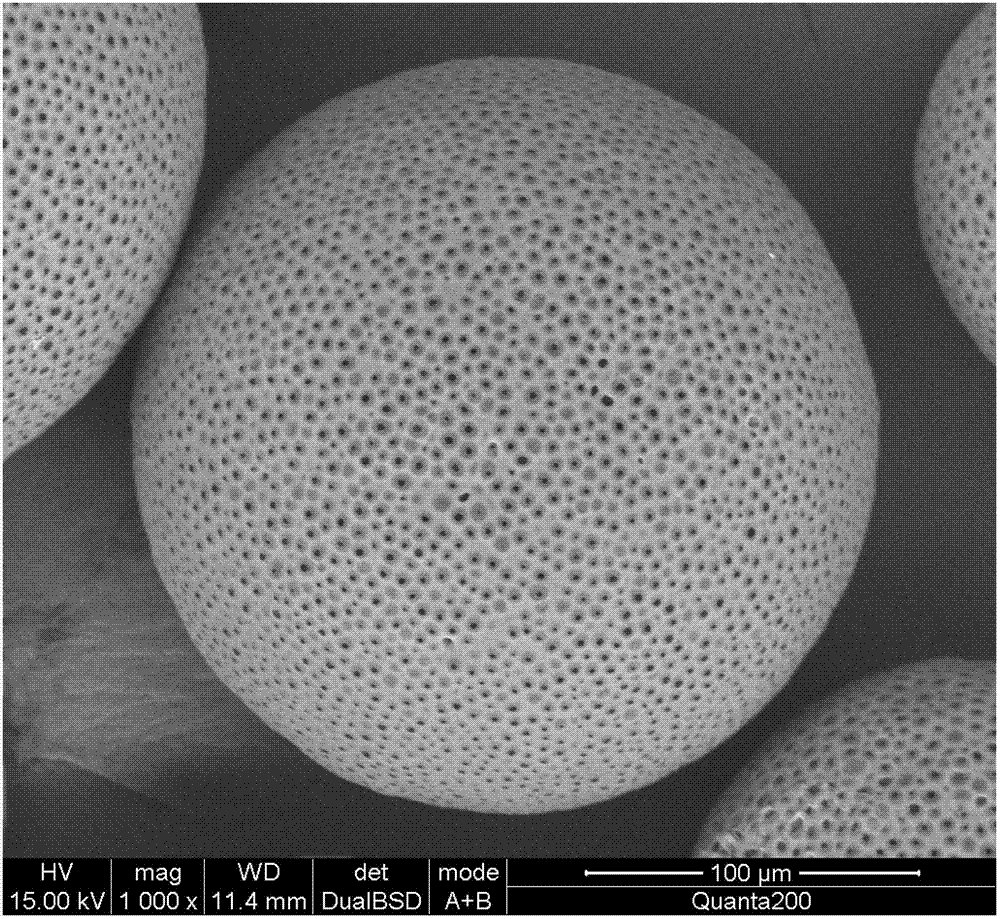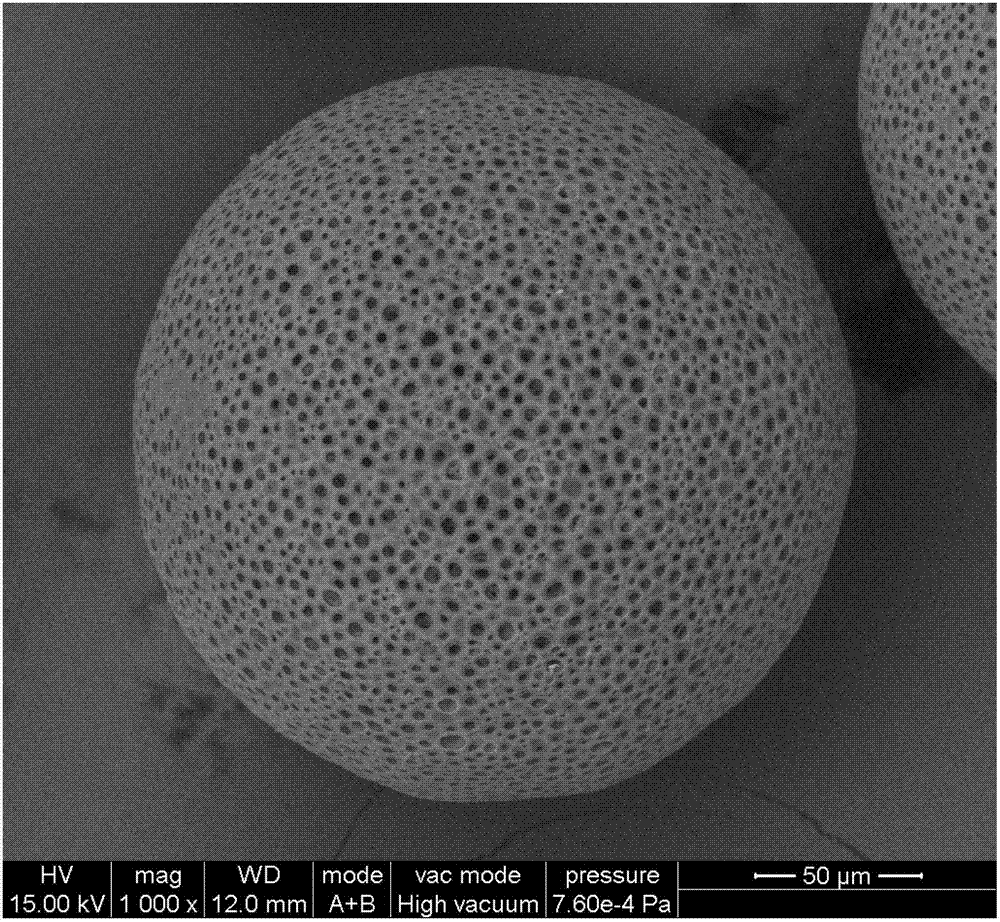Polylactic-co-glycolic acid (PLGA)/calcium carbonate compound microsphere with porous shell and preparation method for compound microsphere
A technology of composite microspheres and calcium carbonate, which is applied in the field of preparation of degradable composite microspheres, can solve problems such as patient trauma, achieve the effects of avoiding residues, facilitating growth, and improving preparation methods
- Summary
- Abstract
- Description
- Claims
- Application Information
AI Technical Summary
Problems solved by technology
Method used
Image
Examples
Embodiment 1
[0029] Weigh 1g of PLGA (50 / 50, Mw=30kDa) and dissolve it in 20ml of dichloromethane to obtain 20ml of PLGA organic solution. Weigh 0.5 g of calcium carbonate powder and add it into the PLGA organic solution, and stir for 10 min at 300 rpm and 300 w ultrasonic power to obtain a PLGA / calcium carbonate mixed solution. Weigh 5g of PVA and add it to 500ml of deionized water, stir for 15min, then heat to 90°C to dissolve the PVA, and obtain a PVA aqueous solution after cooling. Weigh 0.5 g of gluconolactone and dissolve in 500 ml of PVA aqueous solution to obtain an acidic PVA aqueous solution. The PLGA / calcium carbonate mixed solution was added dropwise into the acidic PVA aqueous solution under the stirring condition of 350rpm to obtain an oil-in-water single emulsion. Stir the emulsion continuously (350rpm) in a fume hood for 20 hours to volatilize the dichloromethane in the emulsion and solidify the oil droplets into balls. The obtained microspheres were collected, washed 3 t...
Embodiment 2
[0031] Weigh 2g of PLGA (50 / 50, Mw=30kDa) and dissolve it in 10ml of dichloromethane to obtain 10ml of PLGA organic solution. Weigh 0.2 g of calcium carbonate powder and add it into the PLGA organic solution, and stir for 10 min at 300 rpm and 300 w ultrasonic power to obtain a PLGA / calcium carbonate mixed solution. Weigh 2g of PVA and add it to 250ml of deionized water, stir for 15min, then heat to 90°C to dissolve the PVA, and obtain a PVA aqueous solution after cooling. Weigh 0.3 g of gluconolactone and dissolve in PVA aqueous solution to obtain acidic PVA aqueous solution. The PLGA / calcium carbonate mixed solution was added dropwise into the acidic PVA aqueous solution under the stirring condition of 400rpm to obtain an oil-in-water single emulsion. Keep stirring (400rpm) the emulsion in a fume hood for 20 hours to volatilize the dichloromethane in the emulsion and solidify the oil droplets into balls. The obtained microspheres were collected, washed 3 times with deioniz...
Embodiment 3
[0033] Weigh 1g of PLGA (50 / 50, Mw=30kDa) and dissolve it in 10ml of dichloromethane to obtain 10ml of PLGA organic solution. Weigh 0.05g of calcium carbonate powder and add it to the PLGA organic solution, and stir for 10min at a maximum speed of 300rpm and 300w ultrasonic power to obtain a mixed solution of PLGA / calcium carbonate. Weigh 2g of PVA and add it to 250ml of deionized water, stir for 15min, then heat to 90°C to dissolve the PVA, and obtain a PVA aqueous solution after cooling. Weigh 0.4g of gluconolactone and dissolve in PVA aqueous solution to obtain acidic PVA aqueous solution. The PLGA / calcium carbonate mixed solution was added dropwise into the acidic PVA aqueous solution under the stirring condition of 400rpm to obtain an oil-in-water single emulsion. Keep stirring (250rpm) the emulsion in a fume hood for 20 hours to volatilize the dichloromethane in the emulsion and solidify the oil droplets into balls. The obtained microspheres were collected, washed 3 ti...
PUM
 Login to View More
Login to View More Abstract
Description
Claims
Application Information
 Login to View More
Login to View More - R&D
- Intellectual Property
- Life Sciences
- Materials
- Tech Scout
- Unparalleled Data Quality
- Higher Quality Content
- 60% Fewer Hallucinations
Browse by: Latest US Patents, China's latest patents, Technical Efficacy Thesaurus, Application Domain, Technology Topic, Popular Technical Reports.
© 2025 PatSnap. All rights reserved.Legal|Privacy policy|Modern Slavery Act Transparency Statement|Sitemap|About US| Contact US: help@patsnap.com



